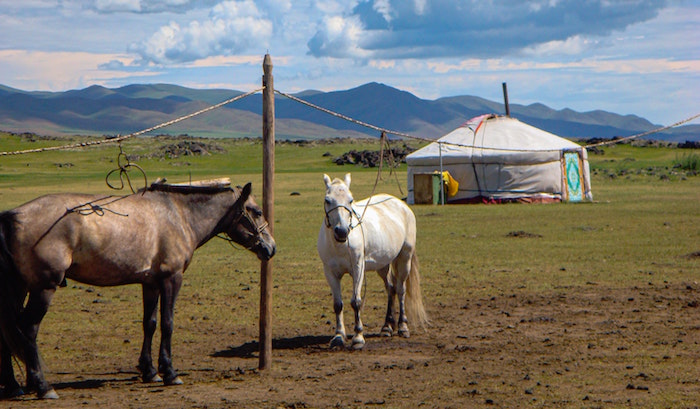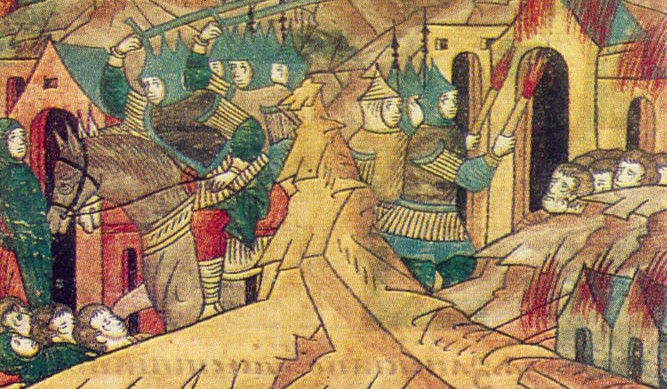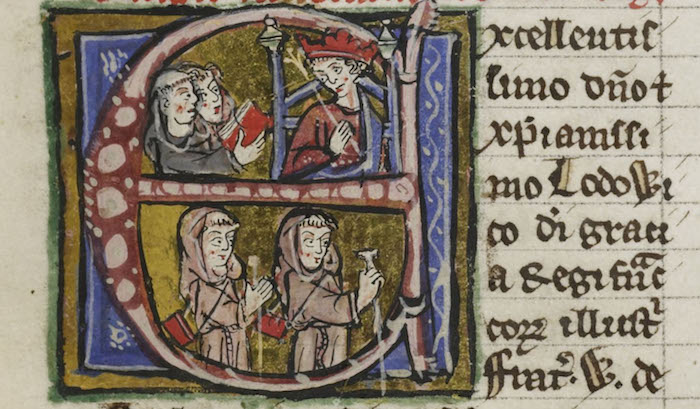The Catholic powers of Medieval Europe didn’t understand the sudden intrusion of the Mongol Empire into their sphere of influence. Nonetheless, nations must communicate with one another, even those they don’t understand. So it came to pass that in 1253 King Louis IX of France dispatched an envoy to the Mongol Empire. Ostensibly, this was a mission of friendship. In practice, it was a request for an alliance. Louis’ emissary had no idea what he was getting into. This week, we’ll talk about the amazing story of his journey to Mongolia. Next week we’ll talk about what he saw and did at the court of the Mongol emperor. Both are amazingly gameable. Let’s dive right in!
This post is brought to you by beloved Patreon backer Arthur Brown. Thanks for helping keep the lights on! If you want to help keep this blog going alongside Arthur, head over to the Patreon page – and thank you!

In the 13th century, word reached Europe of a great army conquering Muslim lands from the east. By 1221, Persia had fallen to these mysterious warriors – the same year that Muslim forces spanked the Catholic Fifth Crusade and sent those crusaders back to Europe. This mystery army surely belonged to Prester John, the mythical Christian king of a powerful, paradisiacal kingdom somewhere in Asia or Africa. But Europeans were disabused of this notion when Mongol forces arrived on their back doorstep. Mongol armies conquered the proto-Russian state of the Kievan Rus (in modern Ukraine) in 1240, and in 1241 and 1242 seized much of modern Hungary, Bulgaria, Poland, Germany, and Austria. But the death of their distant emperor (Ögedei, son of Genghis Khan and second emperor of the Mongols) in 1241 inconvenienced the invasion. Most of Ögedei’s relatives felt compelled to return to Mongolia to participate in the political jockeying to select the next emperor. The invasion stalled and never seriously restarted. Meanwhile, Mongol conquests relevant to Catholic crusaders continued. The Mongol Empire took most of Seljuk Anatolia in 1243 and attacked Ayyubid Syria in 1244.
This is all relevant for understanding what was going through the head of French King Louis IX. Louis was part of the Seventh Crusade (1248-1254), and the Mongols were a new power in the area, apparently aligned against both the crusading Catholics and the defending Muslim states. More confusingly, Louis had heard (correctly) that many Mongols were Christians. They belonged to the Church of the East. This branch of Christianity effectively no longer exists, though there are a few churches that claim continuity with it. But at the time, the Church of the East was the largest Christian denomination by geographic area, stretching from Mongolia to India. Catholics felt the Church of the East was Nestorian, an early Christian heresy that held that Christ had separate human and divine persons. In truth, their theology was more complicated than that, but Catholics still disdained the Church of the East for its perceived heresy.
Louis IX had heard of a Mongol noble – Sartaq, son of Batu – who was supposedly a pious Christian. Sartaq lived in what is today southern Russia. Were he to cross the Caucasus Mountains into Anatolia, he’d be in an area relevant to crusader geopolitics. Wouldn’t it be convenient if Louis could turn Sartaq into a crusader? Previous Catholic political envoys to the Mongols hadn’t accomplished much, so Louis framed his embassy to Sartaq in purely religious terms. He wrote a letter to Sartaq talking about their shared Christian faith and leaving out the part where Sartaq was a gross Nestorian heretic. The letter contained vague platitudes about friendship and the shared brotherhood of Christians. The political implication (“I’m a Christian, you’re a Christian, bring your army over here so we can beat up on Muslims together”) was left unsaid.

To deliver this letter, Louis chose William of Rubruck, a Franciscan friar from Flanders who was part of the crusade. Judging by his writings, William might not have been aware of the political implications of his mission. If he was, he was certainly uncomfortable about it. He saw himself as a missionary, not a political agent. William left for Russia in 1253. He brought with him a small party and an interpreter named Abdullah.
William found Sartaq on a plain near the Caspian Sea. Sartaq lived in an orda, a Mongol tent-town. The Mongol lifestyle required constant movement to find fresh pastures for the livestock they depended on. Yet Sartaq was a lord of sufficient prominence to require a court. He had retainers, wives, slaves, and captains. Thus, like most of his peers, his court was mobile. He had great tents, thirty feet across, with felt walls and stout wooden rafters. When the orda moved, his tents were not taken down, but placed upon wagons. Such a wagon might need as many as twenty-two oxen to pull it. Thus, whenever the grass grew thin, Sartaq uprooted his entire town and the herds that supported it.
William discovered Sartaq was not a Christian. Nonetheless, Sartaq was sympathetic to Christianity. His chief minister, Coiac, was Christian (of the Church of the East). And Sartaq asked William for Christian blessings and had him perform a Catholic mass. There was some awkwardness involving presents. Sartaq expected gifts from envoys, but William was a Franciscan. He’d taken an oath of poverty and couldn’t carry the sorts of gifts Sartaq was used to. Nonetheless, Sartaq was a pretty chill dude and wasn’t bent out of shape about the misunderstanding.
Sartaq was also a much cannier politician than William. He understood, even if William didn’t, that this was a request for an alliance. William protested that he was on a mission of Christian brotherhood and Sartaq ignored him. Making an alliance was above Sartaq’s pay grade. William would have to bring his letter to Sartaq’s father, Batu. William didn’t want to go deeper into Mongol lands, but he couldn’t be rude to his host or fail King Louis. So onward went William, Abdullah, and their party towards Batu.

I mentioned before that William of Rubruk was not the first Catholic emissary to the Mongol Empire – though he was definitely the most gameable. Eight years earlier, Giovanni da Pian del Carpine left Europe carrying a letter from the Pope to the Emperor of the Mongols. (There was also a second embassy to the Mongol Empire between those of Giovanni and William.) Giovanni was a fat Franciscan friar in his mid-60s and a disciple of St. Francis of Assisi personally. Like William, Giovanni encountered a Mongol lord who directed him towards Batu – but Giovanni’s contact wasn’t as convivial as Sartaq would be.
This Mongol lord, whose name Giovanni gives as Corenza, tried to extort gifts from the friar. Unlike William, Giovanni had gifts in his luggage. But his gifts were intended for the Mongol emperor, not whatever lord happened to be guarding the border. Giovanni argued that he was a poor friar and had nothing to give. His party had traveled through the bandit-infested lands of the Lithuanians before reaching Corenza; surely if he had any worthwhile gifts, they’d have already been stolen. Corenza didn’t budge. If Corenza got gifts, Giovanni would be safely escorted to Batu. If Corenza didn’t get gifts, who can say what might happen to Giovanni on the way? Giovanni caved and Corenza got his gifts.
Giovanni also gives us a cool account of a Mongol tradition. Mongol lords liked to make their guests walk between a pair of bonfires. Doing so unwove wicked spells, neutralized poisons, and otherwise magically protected a host from his guests. Giovanni wasn’t thrilled about participating in this pagan ritual, but did what he had to do for the good of his mission.

Anyway, back to William of Rubruck. He arrived at the orda of Batu and delivered his letter. William describes Batu’s orda as a great city, many leagues wide. Batu was one of the most powerful men in the Mongol Empire. There’d been a push to make him emperor, but he liked living in the rich steppelands of Ukraine. Instead, he arranged to have his cousin made emperor. The cousin mostly left Batu alone as the de-facto independent ruler of the western steppe.
Like Sartaq, Batu decreed the question of an alliance was above his pay grade. Only the emperor, three thousand miles away in Mongolia, could make this decision. Batu had William’s letter translated into Mongolian. William later learned to his horror that this translation made the implicit part explicit and directly asked for an alliance between the crusaders (or Catholic Christendom writ large) and the Mongol Empire. Batu then gave William and his party horses and guides and sent them on their way.
It was September; they’d have to cross the steppe in winter. Whenever they encountered Mongol subjects, the guides invoked the name of Batu and traded horses with them. Sometimes this happened several times a day, sometimes only once every few days. This constant supply of fresh mounts and commandeered food let William and his party travel even faster than the emperor’s own messengers. They crossed the steppe in three months.

William had a side project along the way. He knew of a band of Germans who’d been enslaved during the Mongol invasion of Europe. He wanted to find out what had happened to them. In the courts of Sartaq and Batu, he learned they’d been taken east when their master (a great-grandson of Genghis Khan) was recalled and executed for disrespect. As the party traveled east, William asked the people he met if they’d heard of these Germans. Eventually he learned they’d been moved to a particular village where they were forced to mine gold and make weapons. William learned this too late to stop in the village and ask how they were doing – not that his guides would have let him stop anyway.
William’s translator, Abdullah, wasn’t much use on the journey. Before they could reach Mongolia, the party had to travel through the rocky gap between the Altai and Tian-Shan Mountains: the one break in the otherwise-endless grasslands. It’s a scary place! The guides asked William to say some prayers to drive away demons. William did so, no one got carried off by demons, and the guides became curious about William’s Catholic Christianity. The friar tried to answer their questions and perform the proselytization that he (incorrectly) thought was the whole point of his mission. But every time he went to do so, Abdullah the interpreter let him down. It turned out Abdullah didn’t know any Mongolian religious words, so could not translate William’s sermons. This had been been an issue in the ordas of Sartaq and Batu, but now William had a willing audience and no way to reach them! This frustrated the friar to no end.
I suspect Abdullah did this deliberately. Given how long he’d been traveling with Mongols, if he’d wanted to learn religious words from them he could have. But claiming ignorance meant he could steer William away from topics that might get the party killed. In his later writings, William presents Abdullah as ignorant and lazy, but it’s also possible to interpret him as a canny actor on a much longer and more dangerous journey than he’d signed up for, who just wanted to make it home without offending someone with God talk.

I’ve done plenty of other posts about cool things you can do with/to your party while they’re traveling. And I stand by my usual advice there: the best way to make travel both fun and meaningful is to make the travel itself at least some sort of minor adventure, with fun encounters, interesting decisions, and meaningful consequences both good and bad. The voyages of William of Rubruck and Giovanni da Pian del Carpine give us great material for such adventures.
William and Giovanni had some fun encounters that made sense given where they were and what they were doing. Guides who were brave on the familiar steppe grew fearful in the journey’s one rocky section. Corenza extorted gifts from Giovanni. Batu made Giovanni undergo a supernatural ritual because the friar was an untrustworthy outsider. These are encounters that reinforce the nature of the journey.
And two of these encounters represent a sort of ‘gatekeeper’ who must be convinced to let the party pass. For William, these were Sartaq and Batu. For Giovanni, they were Corenza and Batu. Two gatekeepers is a great number because how you handle the first can influence how the second handles you. (If Giovanni had handled Corenza badly, maybe he’d not have lived to see Batu.) But any more than two gatekeepers risks feeling repetitive. A gatekeeper is a great encounter because it’s both a roleplay encounter and a puzzle, so it will probably engage more players than either kind of encounter alone.

William also gave himself a task while traveling: finding out what happened to those German slaves. Encouraging your players to do this gives them a greater sense of agency. It also gives you another source of fun encounters. “Hey Kathy, you know how you said you always ask passers-by if they want to buy one of the knives you’re always making? After a week of travel, you meet somebody who wants to buy a knife.” Then that knife-buyer can let slip something useful the PCs will appreciate knowing later in the session.
Finally, we have Abdullah, a recurring NPC who seemingly exists only to complicate the PCs’ lives. I wouldn’t personally put a translator in this role (I don’t find overcoming language barriers to be fun roleplay, though many people I know do), but you can get the same effect from an unreliable wagon-driver, a dog who’s always getting into the stored food, or an AI assistant who’s always playing video games. Right when you need them the most, they’re of no use at all. These sorts of complications turn dull, predictable encounters into tense, memorable ones.
Come back next week when we’ll cover the second half of William’s trip with part two: The Court of the Khan!






